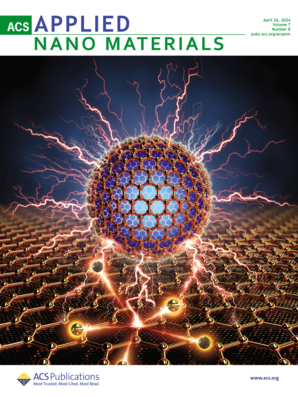Construction of Ultrathin CuAuAg Nanosheet-Assembled Three-Dimensional Nanoflowers for Photothermal Conversion and Electrocatalytic Hydrogen Evolution
IF 5.5
2区 材料科学
Q2 MATERIALS SCIENCE, MULTIDISCIPLINARY
引用次数: 0
Abstract
Ultrathin two-dimensional (2D) nanostructures, with superhigh exposure of the under-coordinated metal atoms relative to large-sized quasi-spherical particles or bulk counterparts, have shown enormous potential to enhance various heterogeneous catalytic reactions. The creation of in-plane holes and rational assembling of ultrathin 2D nanosheets into 3D hierarchical architectures can prevent the restacking issue of nanosheets, thereby providing more active sites by hampering atomic diffusion, nearby nanosheet aggregation, and thermodynamic structural reform. Herein, we report the stepwise construction of ultrathin CuAuAg nanosheet-assembled 3D nanoflowers (NFs). The synthesis involves the conversion of Au@CuxO mesoporous nanospheres into CuAg NFs, followed by a controlled galvanic replacement reaction with chloroauric acid to create holes and manipulate the atomic ratio between Cu, Au, and Ag. With strong broad-spectrum light absorption across the UV–vis region, the current CuAuAg NFs exhibited satisfactory photothermal conversion under Xe lamp irradiation. When serving as HER electrocatalysts, the Cu10.5Au58.4Ag31.1 NFs displayed the optimized performance in terms of overpotential and activity, surpassing the Cu71.4Ag28.6 NFs and Au NCs, which is supported by DFT simulations, showcasing the multimetallic coupling advantage for HER. This study presents a viable route to construct trimetallic 3D hierarchical nanostructures and validates their application in photothermal conversion and electrocatalytic HER, guiding the design of high-performance photosensitizers and electrocatalysts.

构建用于光热转换和电催化氢气生成的超薄铜铝银纳米片组装三维纳米流
超薄二维(2D)纳米结构与大尺寸准球形颗粒或块状对应物相比,具有超高的欠配位金属原子暴露率,在增强各种异相催化反应方面显示出巨大的潜力。创建平面内孔并将超薄二维纳米片合理地组装成三维分层结构,可以防止纳米片的重新堆积问题,从而通过阻碍原子扩散、附近纳米片聚集和热力学结构改革提供更多的活性位点。在此,我们报告了逐步构建超薄铜金银纳米片组装三维纳米花(NFs)的过程。合成过程包括将 Au@CuxO 介孔纳米球转化为 CuAg NFs,然后与氯尿酸进行可控的电化学置换反应,以产生空穴并调节 Cu、Au 和 Ag 之间的原子比例。当前的 CuAuAg NFs 在紫外-可见光区域具有很强的宽光谱光吸收能力,在氙灯照射下可实现令人满意的光热转换。在用作 HER 电催化剂时,Cu10.5Au58.4Ag31.1 NFs 在过电位和活性方面表现出最佳性能,超过了 Cu71.4Ag28.6 NFs 和 Au NCs。该研究提出了构建三金属三维分层纳米结构的可行途径,并验证了它们在光热转换和电催化 HER 中的应用,为高性能光敏剂和电催化剂的设计提供了指导。
本文章由计算机程序翻译,如有差异,请以英文原文为准。
求助全文
约1分钟内获得全文
求助全文
来源期刊

ACS Applied Nano Materials
Multiple-
CiteScore
8.30
自引率
3.40%
发文量
1601
期刊介绍:
ACS Applied Nano Materials is an interdisciplinary journal publishing original research covering all aspects of engineering, chemistry, physics and biology relevant to applications of nanomaterials. The journal is devoted to reports of new and original experimental and theoretical research of an applied nature that integrate knowledge in the areas of materials, engineering, physics, bioscience, and chemistry into important applications of nanomaterials.
 求助内容:
求助内容: 应助结果提醒方式:
应助结果提醒方式:


